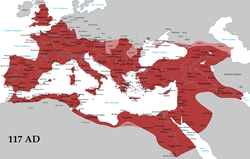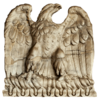Roman Empire | |||||||||||
|---|---|---|---|---|---|---|---|---|---|---|---|
| 27 BC – AD 395 (unified)[a] AD 395 – 476/480 (Western) AD 395–1453 (Eastern) | |||||||||||
Imperial aquila
| |||||||||||
 Roman Empire in AD 117 at its greatest territorial extent, at the time of Trajan's death | |||||||||||
 Roman territorial evolution from the rise of the city-state of Rome to the fall of the Western Roman Empire | |||||||||||
| Capital |
| ||||||||||
| Common languages | |||||||||||
| Religion |
| ||||||||||
| Demonym(s) | Roman | ||||||||||
| Government | Autocracy | ||||||||||
• Emperor | (List) | ||||||||||
| Historical era | Classical era to Late Middle Ages (Timeline) | ||||||||||
| Area | |||||||||||
| 25 BC[16] | 2,750,000 km2 (1,060,000 sq mi) | ||||||||||
| AD 117[16][17] | 5,000,000 km2 (1,900,000 sq mi) | ||||||||||
| AD 390[16] | 3,400,000 km2 (1,300,000 sq mi) | ||||||||||
| Population | |||||||||||
• 25 BC[18] | 56,800,000 | ||||||||||
| Currency | Sestertius,[e] aureus, solidus, nomisma | ||||||||||
| |||||||||||
The Roman Empire ruled the Mediterranean and much of Europe, Western Asia and North Africa. The Romans conquered most of this during the Republic, and it was ruled by emperors following Octavian's assumption of effective sole rule in 27 BC. The western empire collapsed in 476 AD, but the eastern empire lasted until the fall of Constantinople in 1453.
By 100 BC, Rome had expanded its rule to most of the Mediterranean and beyond. However, it was severely destabilized by civil wars and political conflicts, which culminated in the victory of Octavian over Mark Antony and Cleopatra at the Battle of Actium in 31 BC, and the subsequent conquest of the Ptolemaic Kingdom in Egypt. In 27 BC, the Roman Senate granted Octavian overarching military power (imperium) and the new title of Augustus, marking his accession as the first Roman emperor. The vast Roman territories were organized into senatorial provinces, governed by proconsuls who were appointed by lot annually, and imperial provinces, which belonged to the emperor but were governed by legates.[19]
The first two centuries of the Empire saw a period of unprecedented stability and prosperity known as the Pax Romana (lit. 'Roman Peace'). Rome reached its greatest territorial extent under Trajan (r. 98–117 AD), but a period of increasing trouble and decline began under Commodus (r. 180–192). In the 3rd century, the Empire underwent a 50-year crisis that threatened its existence due to civil war, plagues and barbarian invasions. The Gallic and Palmyrene empires broke away from the state and a series of short-lived emperors led the Empire, which was later reunified under Aurelian (r. 270–275). The civil wars ended with the victory of Diocletian (r. 284–305), who set up two different imperial courts in the Greek East and Latin West. Constantine the Great (r. 306–337), the first Christian emperor, moved the imperial seat from Rome to Byzantium in 330, and renamed it Constantinople. The Migration Period, involving large invasions by Germanic peoples and by the Huns of Attila, led to the decline of the Western Roman Empire. With the fall of Ravenna to the Germanic Herulians and the deposition of Romulus Augustus in 476 by Odoacer, the Western Empire finally collapsed. The Eastern Roman Empire survived for another millennium with Constantinople as its sole capital, until the city's fall in 1453.[f]
Due to the Empire's extent and endurance, its institutions and culture had a lasting influence on the development of language, religion, art, architecture, literature, philosophy, law, and forms of government across its territories. Latin evolved into the Romance languages while Medieval Greek became the language of the East. The Empire's adoption of Christianity resulted in the formation of medieval Christendom. Roman and Greek art had a profound impact on the Italian Renaissance. Rome's architectural tradition served as the basis for Romanesque, Renaissance and Neoclassical architecture, influencing Islamic architecture. The rediscovery of classical science and technology (which formed the basis for Islamic science) in medieval Europe contributed to the Scientific Renaissance and Scientific Revolution. Many modern legal systems, such as the Napoleonic Code, descend from Roman law. Rome's republican institutions have influenced the Italian city-state republics of the medieval period, the early United States, and modern democratic republics.
- ^ Morley, Neville (2010). The Roman Empire: Roots of Imperialism. Pluto Press. ISBN 978-0-7453-2870-6.; Diamond, Jared (2011). Collapse: How Societies Choose to Fail or Succeed (Revised ed.). Penguin. p. 13. ISBN 978-1-1015-0200-6.
- ^ Sandberg, Kaj (2008). "The So-Called Division of the Roman Empire in AD 395: Notes on a Persistent Theme in Modern Historiography". Arctos. 42: 199–213. ISSN 0570-734X.
- ^ Bennett (1997).
- ^ a b Ancient Rome: The Definitive Visual History. Dorling Kindersley. 2023. p. 276. ISBN 978-0-2416-3575-9. Archived from the original on 22 June 2023. Retrieved 26 April 2023.
- ^ Classen, Albrecht (2010). "The changing shape of Europe". Handbook of Medieval Studies. Walter de Gruyter. ISBN 978-3-1102-1558-8. Archived from the original on 10 March 2024. Retrieved 26 April 2023.
Constantine the Great transferred the capital of the Roman Empire from Rome to the newly-founded city of Constantinople
- ^ Price, Jonathan J.; Finkelberg, Margalit; Shahar, Yuval (2022). Rome: An Empire of Many Nations. Cambridge University Press. p. 19. ISBN 978-1-0092-5622-3. Archived from the original on 22 June 2023. Retrieved 26 April 2023.
the capital of the Empire was transferred from Rome to Constantinople in the fourth century
- ^ Erdkamp, Paul (2013). The Cambridge Companion to Ancient Rome. Cambridge University Press. p. 202. ISBN 978-0-5218-9629-0.
Constantine sounded the death knell for Rome as a vital political centre with the dedication of his new imperial capital at Constantinople
- ^ Bjornlie, M. Shane (2013). Politics and Tradition Between Rome, Ravenna and Constantinople: A Study of Cassiodorus and the Variae, 527–554. Cambridge University Press. p. 41. ISBN 978-1-1070-2840-1. Archived from the original on 22 June 2023. Retrieved 26 April 2023.
As a new capital, Constantinople provided a stage for imperial prestige that did not depend on association with the traditions of the senatorial establishment at Rome
- ^ Coffler, Gail H. (2004). Melville's Allusions to Religion: A Comprehensive Index and Glossary: A Comprehensive Index and Glossary. ABC-CLIO. p. 181. ISBN 978-0-3130-7270-3. Archived from the original on 22 June 2023. Retrieved 26 April 2023.
It became Constantinople, capital of the entire Roman Empire
- ^ Maxwell, Kathleen (2016). "Art and Diplomacy in Late Thirteenth-century Constantinople: Paris 54 and the Union of Churches". Between Constantinople and Rome: An Illuminated Byzantine Gospel Book (Paris gr. 54) and the Union of Churches. Routledge. ISBN 978-1-3519-5584-3. Archived from the original on 22 June 2023. Retrieved 26 April 2023.
Constantine the Great, the emperor who moved the capital of the Roman Empire from Rome to Constantinople
- ^ Grig, Lucy; Kelly, Gavin (2012). Two Romes: Rome and Constantinople in Late Antiquity. Oxford University Press. p. 237. ISBN 978-0-1999-2118-8. Archived from the original on 10 March 2024. Retrieved 26 April 2023.
- ^ Loewenstein, K. (2012). The Governance of ROME. Springer. p. 443. ISBN 978-9-4010-2400-6. Archived from the original on 22 June 2023. Retrieved 26 April 2023.
- ^ Harris, Jonathan (2009). Constantinople: Capital of Byzantium. A&C Black. p. 31. ISBN 978-0-8264-3086-1. Archived from the original on 22 June 2023. Retrieved 26 April 2023.
- ^ Treadgold (1997), p. 734.
- ^ Tricht, Filip Van (2011). The Latin Renovatio of Byzantium: The Empire of Constantinople (1204–1228). Brill. pp. 61–82. ISBN 978-9-0042-0323-5. Archived from the original on 6 April 2023. Retrieved 26 April 2023.
- ^ a b c Taagepera, Rein (1979). "Size and Duration of Empires: Growth-Decline Curves, 600 B.C. to 600 A.D". Social Science History. 3 (3/4): 125. doi:10.2307/1170959. ISSN 0145-5532. JSTOR 1170959.
- ^ Turchin, Peter; Adams, Jonathan M.; Hall, Thomas D. (2006). "East-West Orientation of Historical Empires" (PDF). Journal of World-Systems Research. 12 (2): 222. Archived from the original (PDF) on 17 May 2016. Retrieved 5 February 2016.
- ^ Durand, John D. (1977). "Historical Estimates of World Population: An Evaluation". Population and Development Review. 3 (3): 253–296. doi:10.2307/1971891. JSTOR 1971891. Archived from the original on 16 October 2019. Retrieved 30 October 2018.
- ^ "Imperial Rome vs. Provincial Rome: What's The Difference?". TheCollector. 7 October 2020. Retrieved 16 May 2024.
- ^ Roy, Kaushik (2014). Military Transition in Early Modern Asia, 1400–1750: Cavalry, Guns, Government and Ships. Bloomsbury Studies in Military History. Bloomsbury Publishing. p. 37. ISBN 978-1-7809-3800-4.
After the capture of Constantinople, the capital of the Byzantine Empire became the capital of the Ottoman Empire. The Osmanli Turks called their empire the Empire of Rum (Rome).
Cite error: There are <ref group=lower-alpha> tags or {{efn}} templates on this page, but the references will not show without a {{reflist|group=lower-alpha}} template or {{notelist}} template (see the help page).
